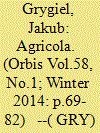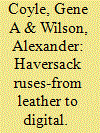|
|
|
Sort Order |
|
|
|
Items / Page
|
|
|
|
|
|
|
| Srl | Item |
| 1 |
ID:
126761


|
|
|
|
|
| Publication |
2013.
|
| Summary/Abstract |
Gnaeus Julius Agricola (40-93 AD) is a man for our times. Facing the capriciousness of imperial power, he, a successful provincial Roman governor, chose to withdraw from public administration. Yet, by protecting his family, Agricola did not shirk politics. On the contrary, he retreated to the founding cell of any polity, the family, which buttresses and at the same time limits the state. By doing so, Agricola reached greatness despite living under bad emperors.
|
|
|
|
|
|
|
|
|
|
|
|
|
|
|
|
| 2 |
ID:
128297


|
|
|
|
|
| Publication |
2014.
|
| Summary/Abstract |
...sic fata gradus evaserat altos, semianimemque sinu germanam amplexa fovebat cum gemitu atque atros siccabat veste cruores. illa gravis oculos conata attollere rursus de?cit; in?xum stridit sub pectore vulnus.
ter sesc attollcns cubitoquc adnixa levavit, ter revoluta toro est oculisque errantibus alto quacsivit caelo lucem ingemuitque repcrta. Tum luno omnipotens longum miserata dolorem dif?cilisque obitus lrim demisit Olympo quae luctantem animam nexosque resolvcret arms. nam quia nec fato merita nec morte peribat,
sed misera ante diem subitoque accensa furore, nondum illi flavum Proserpina vertice crinem abstulerat Stygioque caput damnaverat Orco. ergo Iris croceis per caelum roscida pennis millc trahcns varios advcrso sole colores devolat et supra caput astitit. 'hunc ego Diti sacrum iussa fero teque isto corpore solve': sic ait et dextra crinem secat. omnis et una dilapsus calor atque in ventos vita recessit.
|
|
|
|
|
|
|
|
|
|
|
|
|
|
|
|
| 3 |
ID:
130233


|
|
|
|
|
| Publication |
2014.
|
| Summary/Abstract |
The historical record of a country allowing false documents to fall into the hands of its enemy in order to deceive him goes back at least as far as the third century B.C., when Hannibal fought the Romans. 1 Yet, the ploy of misleading an enemy through the "passage" of fake documents to the other side probably reached its zenith during the twentieth century's First and Second World Wars, especially with a few spectacular cases involving an allegedly wounded courier and, once, even a dead one. Because of the famous British deception ploy in Palestine against the Turks in 1917, most all such deceptions came to be known as "haversack ruses." The king of all such ruses, at least in terms of being the best-known through numerous books and even a movie, was Operation MINCEMEAT of World War II. This elaborate British ploy of 1943 employed a dead body, a submarine to deliver it off the coast of Spain, false documents to deceive Germany's Adolf Hitler about the date and location of an anticipated Allied invasion of southern Europe, and the painstaking creation and backstopping of "The Man Who Never Was."
The purpose of examining variations of this type of ruse is to determine if these ploys featured any common characteristics, as well as any commonality in the backgrounds and personalities of the people who came up with or implemented such ideas. Did they include traits that make for a good deception officer? One of the World War II "deceivers," Sefton Delmer, wrote years later that, in wartime London, many of his most successful deception ideas came to him while drinking vintage champagne at Frascati's, his favorite expensive restaurant with its plush chairs and elderly waiters. 2
At first glance, the haversack ruses seem to have ended with the close of World War II, but perhaps the medium simply changed from leather satchels to digital ones. The challenge of looking at relatively recent "digital haversack" deceptions is that most instances remain classified, but a few Western ploys against the Soviet Union in the early 1980s have entered the public domain. The delivery methods of modern deceptions have changed, but the goal of misleading the enemy is still the same. Although no exciting tales involving dead bodies have surfaced-just the use of dull digital zeros and ones from computer files-the results may occasionally be equally exciting. And the need still exists for imaginative, operational minds in today's deception operations.
|
|
|
|
|
|
|
|
|
|
|
|
|
|
|
|
|
|
|
|
|